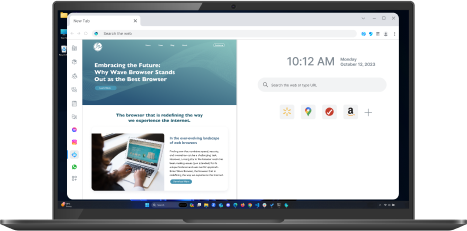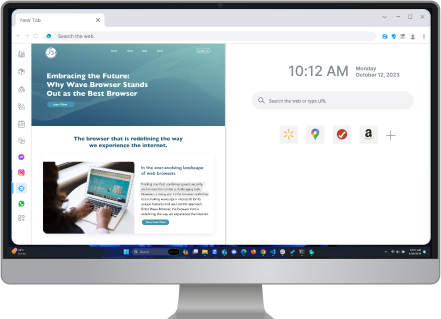Understanding Remote Browser Isolation Strategies
Table of Contents

Imagine going online without worrying about harmful content. That’s what remote browser isolation offers. It is a cybersecurity tool that keeps a user’s web browsing safe in a protected, off-device setting.
With cyber threats lurking at every corner, it’s more important than ever to safeguard our personal information. By creating a secure, isolated browsing environment, it shields us from web-based threats.
When combined with other security tools like secure web gateways (SWGs), remote browser isolation forms a powerful defense, keeping us safe from the dangers of the digital world.
What is Remote Browser Isolation?
Remote browser isolation, known as RBI, is a way to keep a user's web browsing separate from their local device and network. With RBI, all the web content gets processed in a safe, isolated space called a container on a remote server.
This separation means that any harmful content discovered while browsing stays in that secure environment and does not affect the user’s device and network. Instead of clicking on websites directly, users see a visual version of the web content, which is streamed from the remote browser to their local device.
By keeping the browser session isolated, RBI creates a strong barrier that stops malware or ransomware from reaching the user's system. This makes it a great tool for reducing the risks of web browsing and improving overall security.
How Remote Browser Isolation Enhances Web Security
By isolating web browsing activity, RBI stops malicious code from directly interacting with a user’s device, whether this code is known or not.
This proactive step is very good at handling zero-day threats. These are vulnerabilities that security vendors do not yet know about, making them hard to defend using regular security methods. With RBI, if a user comes across a zero-day exploit, the effects are kept within the isolated environment.
RBI works well with modern security systems like Secure Access Service Edge (SASE). This is a cloud-based security setup that combines networking and security functions. This teamwork boosts web security by giving a full defense that protects users and data across the network.
The Mechanism Behind Remote Browser Isolation
Remote browser isolation changes how people use the internet. It separates what users do on websites from how that web content is processed. When someone wants to visit a website, the remote browser isolation system sends that request to a remote server. There, a virtual browser is made.
This virtual browser is safe in its own space. It loads and runs the site the user wants to visit. Everything like clicking links and entering information happens in this secure, remote environment.
The Role of Virtual Browsers in Isolating Threats
The idea of isolated browsing is very important for how RBI works. Instead of using their own web browser on their device, users connect with a virtual browser on a remote server. This virtual browser runs in its own safe area, known as a lightweight virtual machine. This way, any harmful code found while browsing the web cannot get to the user's device.
You can think of it like browsing the web inside a secure bubble. Even if the bubble touches something harmful, the user remains safe. These virtual browser instances are temporary. They are made for each browsing session. When the user ends the session, the browser is completely destroyed.
This method makes sure that any malware or harmful scripts encountered in one browsing session do not move to another session. This gives extra protection to the user's security.
Understanding the Data Flow in Remote Isolation
When a user initiates a browsing session through an RBI solution, their web traffic takes a different route than traditional web browsing. Instead of going directly to the target website, the traffic is routed through the remote server where the isolated browsing session is hosted. This server acts as an intermediary, filtering and sanitizing the web content before it is passed on to the user’s device.
To prevent data loss and unauthorized access to sensitive data, RBI solutions implement robust security measures. Encryption is used to protect web traffic while it is in transit between the user's device and the remote server, preventing eavesdropping and man-in-the-middle attacks. Additionally, access to the remote browsing environment is strictly controlled, and the virtual browser instances are regularly monitored for any suspicious activity.
Advancements in Remote Browser Isolation Technology
Early methods of remote browser isolation used a technique called pixel pushing. In this method, a remote server took a picture of the website and sent it as a series of pixels to the user’s device. This helped keep threats away, but it had some downsides. It used a lot of bandwidth and caused delays, leading to a poor user experience.
As technology changed, the ways of doing remote browser isolation improved too. Today's RBI solutions use advanced techniques. They focus on better security and a smoother user experience. They make data transfer more efficient and cut down on delays.
From Pixel Pushing to Advanced DOM Manipulation
One big improvement is DOM manipulation. This means working with the Document Object Model (DOM) of a website. The DOM is a way to handle HTML and XML documents. It shows how documents are set up and how they can be accessed and changed.
For web browsing, the DOM shows the layout of a web page. RBI solutions that use DOM manipulation take the website's DOM on the remote server. They then rebuild the web page's structure and design on the user's device. This method helps save bandwidth compared to pixel pushing.
This technique offers a smoother and faster browsing experience. It also gives better control over web content. Administrators can block certain parts, like iframes or scripts that might be unsafe, without stopping the rest of the website from working.
The Evolution Towards More Efficient Isolation Techniques
The ongoing changes in remote isolation technologies aim to deal with new online threats and meet the needs of modern web browsing. Websites are getting more complex and use more resources. So, RBI solutions must adapt to manage this without losing security or performance.
There is now a greater focus on adding RBI to larger security systems like the Zero Trust model. Zero Trust means that no one, whether a user or device, is trusted automatically. Every access has to be verified. RBI fits well with the Zero Trust approach by enforcing strict access controls and keeping web browsing activity separate. This helps reduce risks and boost data security.
Looking ahead, we can anticipate improvements in performance and how RBI works with artificial intelligence (AI) and machine learning (ML) for smarter threat detection and responses. The aim is clear. We need to provide a safe browsing experience that protects users and organizations from changing online threats.
Remote Browser Isolation is a new technology that improves web security by protecting against online threats. It works by isolating browsing sessions, which stops harmful attacks from entering the network and keeps your data safe. With better tools and methods for isolation, organizations can strengthen their security more effectively. This technology is important for fighting tricky cyber threats and provides a smart way to improve web security. Use Remote Browser Isolation to enhance your defense and reduce risks.
Frequently Asked Questions

What Makes Remote Browser Isolation Necessary?
Organizations are facing more security risks due to growing web threats, such as phishing attacks, malicious websites, and insider threats. The RBI addresses these issues by opening web content in a safe environment. This approach stops harmful activities from affecting the user's device directly.
How Does Remote Browser Isolation Differ from Traditional Security Measures?
Browser isolation is different from traditional security methods. Instead of just detecting and blocking threats, it emphasizes isolating web content. This approach supports the Zero Trust security model. It treats web content as untrusted and keeps it separate from your device. This ensures a strong level of protection for users.
Can Remote Browser Isolation Work with Any Web Browser?
RBI works with any web browser. This means you can use it on any device. When you start web browsing, RBI takes care of keeping things separate. It gives you a nearly native browser experience without needing a special remote web browser.
What Impact Does Remote Browser Isolation Have on Internet Browsing Speed?
Modern RBI solutions focus on making user experience better by reducing any slowdown in browsing speed. With ongoing improvements and changes, internet users enjoy smooth web browsing activity with very little delay. This means they have almost instant interactions with websites.
How Can Organizations Get Started with Remote Browser Isolation?
IT and security teams need to first look at what their organization’s network needs for security. They should find out where sensitive information is often accessed. Choosing and using the right RBI solutions is important. These solutions should work well with the security tools that are already in place. This helps to keep the organization’s data safe.
Surf with Ease, Speed, and Security!

Download Wave Browser for a seamless online experience like never before. Try it now!


























